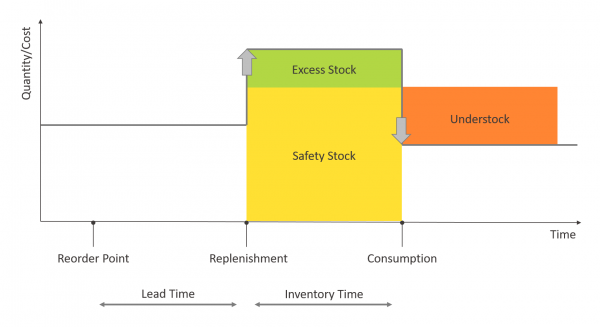While the supply chain is the cornerstone of any manufacturing or retail company, it also bears the most significant costs. Defining optimal inventory levels for warehouses through safety stock requires a good understanding of suppliers’ behavior, components usage/consumption, and finally a well defined service level. The latter embodies the key decision made by an inventory manager: the trade-off between inventory costs and service level. That is, the likelihood the need for a component can be satisfied (either to be used in the assembly of a final product, or as a sale to a customer).
Historically, various “rules of thumb” approaches exist for inventory planning: Forward/Weeks of Supply, Stock to Sales Ratio, Sell Through Percent, Turn, and Basic Stock. What’s common amongst these approaches is the use of significant simplifications.
Completing analyses on the individual component level using detailed and accurate historical data is already a big boost. For the supply side, all historical lead times and their evolution are available. Monitoring lead times allows early identification of troublesome suppliers/parts. For future consumption, the tried and proven ARIMA time series analysis method is used.
This automated approach - to provide the expected supply and consumption - already simplifies and raises the accuracy of the inventory manager’s job. By defining expected service levels, overstock/understock becomes clearly identifiable in line with the agreed methodology and base data.
The implementation of this approach at the given customer resulted in the immediate identification and savings of over EUR 1 million of excess stock.
Results:
A KNIME-based forecasting and optimization solution achieves optimal inventory levels by providing and synthesizing:
- Historic inventory usage and key metrics
- An understanding of suppliers‘ behavior
- Consumption forecasts
- Calculation of safety stock level taking into account the chosen service level
- Order plans and possibly feeding them back into a supply chain management system
This business case uses KNIME Server WebPortal, a comprehensive business application that not only guides the business user though the analytical thought process, but makes the decision actionable by writing back the calculated order plan to the supply chain management system.
Try it out for yourself!
Access reference workflows and data from within KNIME via the Examples Server:
50_Applications/41_Inventory_Optimization
Download Innovation Note here:


